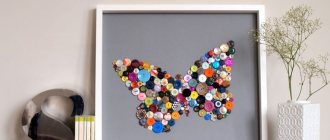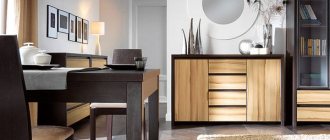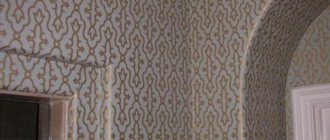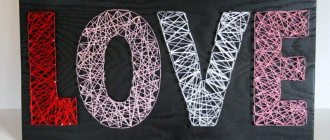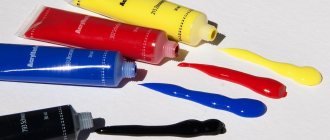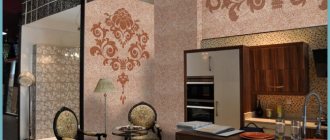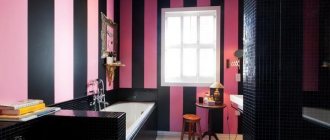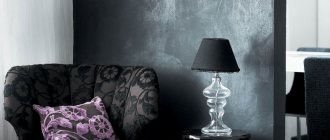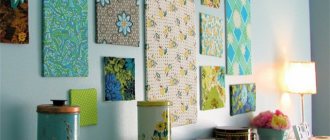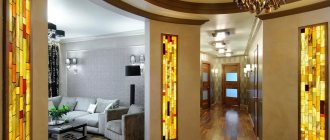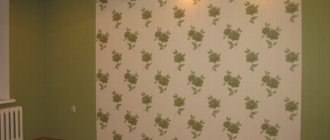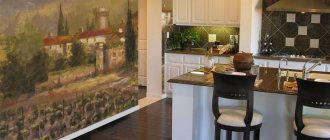Standard houses, identical furnishings, renovations “just to make sure they are clean” – all this is a thing of the past. Now any person has the opportunity to organize their life and decorate their apartment not only based on their budget, but also taking into account their own aesthetic taste. Manufacturers offer a lot of different materials to implement an interesting design, but only designs made from liquid wallpaper can add originality to the interior and make it unique. With even a little artistic skill, you can easily create a museum-quality masterpiece at home.
Features of drawings with liquid wallpaper on the wall
The practical capabilities of the composition have made this type of interior creativity extremely popular, and its plasticity and ease of use have expanded the scope of its application in design: now you can create entire pictures that will delight you and your household for years. In addition to the above, wallpaper for walls has a number of advantages over other finishing materials:
- safe for health;
- high degree of heat and sound insulation;
- the possibility of applying the mass to the working surface with a tool or by hand;
- the relief is smoothed with a rubber float, and the depth of the volumetric composition is formed with a spatula or knitting needles;
- minimal wall preparation required;
- ease of correcting mistakes (just moisten the unnecessary fragment and remove it with a spatula);
- the joints between the layers of material are not visible;
- independent preparation allows you to create the shade that is needed for the idea;
- For creativity, you can use complex, curved surfaces of even a small area.
Before work, old coatings are removed from the walls, deep defects are puttied and surfaces are primed. Next, apply a background layer and wait until it dries completely. Then they begin to create the drawing.
In this case, the main condition for obtaining a high-quality image will be the obligatory observance of time for drying each layer. The work is, of course, painstaking, but the result is worth it.
Guidelines for creating images
Drawings on liquid wallpaper look great in any room, and their environmental safety allows them to be used even in a nursery. When choosing a theme, proceed from the concept of the room and style direction:
- in the bedroom, calm, relaxing landscapes in neutral shades are preferred;
- It is better to discuss the design of the nursery with the child (usually cartoon characters, cars);
- geometric shapes are most often used to decorate the living room;
- in the kitchen they draw still lifes, silhouettes of dishes, and the city in perspective.
Having decided on the idea, create a sample of the future painting and select colors for the composition.
Decorating walls with images is possible in several ways:
- using a stencil;
- drawing the outline of the sketch immediately on the surface;
- projection of an outline using a lamp and glass.
Choose any method to realize your idea, taking into account your artistic skills.
For work, purchase a white mixture, which you will paint in the desired colors during the process with pigments.
Don’t immediately take on complex compositions; start gaining experience with two-color patterns or geometric shapes (diamonds will look great in the living room).
What you will need
To create a pattern with liquid wallpaper, in addition to the desire to create, you will need:
- trowel for applying the mass;
- grater for smoothing the relief;
- roller to add structure to the composition;
- spatula or spatula for distributing the composition;
- ready-made mixture (read the instructions carefully: it takes 6-7 hours to activate the components);
In addition, prepare felt-tip pens or wax crayons; you will need them to outline the contour of the dried design.
Useful tips
- There is no need to decorate the walls with too large drawings, as this visually reduces the area of a small room.
- When preparing walls, do not use ST-17 primer, as when it comes into contact with liquid wallpaper, yellow spots form on the walls.
Liquid wallpaper is recommended for both offices and ordinary apartments and houses. Due to the variety of shades, beautiful texture, and ease of application, they are in demand among all categories of the population. By choosing liquid wallpaper, you can be sure that the interior of your home will be unusual.
How to apply a design using a stencil
Transferring an image using a ready-made form is the most convenient way; it is suitable for people who do not have artistic skills. With its help, they create unusual three-dimensional drawings or flat paintings. You can make stencils for liquid wallpaper with your own hands or purchase ready-made ones.
The main thing when working with stencils is reliable fixation to the wall, so when purchasing, choose templates with an adhesive base.
What do you need for this?
To work, in addition to tools and ready-made mass, you need to stock up on masking tape and purchase or make a stencil. To do this, the selected image is printed and transferred in its original size onto a thick sheet of cardboard. Then it is carefully cut out along the contour and attached to the wall using paper adhesive tape.
Drawing "Curls"
Step-by-step instruction
Drawings on liquid wallpaper require preliminary preparation of the surface, which includes cleaning, priming and applying a background. After the time required for drying has passed, begin creating the image through the stencil:
- secure the template to the surface;
- Apply a layer of mass with a spatula so that the colors involved in the composition do not touch;
- smooth the relief with a damp grater to create a flat picture;
- applying the next layer is possible only after the previous one has dried;
- finishing work consists of drawing contours and a protective coating.
The structure is added to the design using a roller with special attachments, but only after the work has dried. When working with volumetric elements, layer by layer is applied, forming a bulge and maintaining the exposure time. The relief is created using grooves, pressing them with knitting needles, a spatula or a spatula.
Video
Watch video tutorials on decorating the interior of an apartment with drawings on the walls:
Preparation of liquid wallpaper
It is necessary to soak liquid wallpaper based on the total amount that you need to apply to the entire surface to be treated. Before starting work, of course, you need to at least approximately determine the required flow rate in order to know how much mixture you need to buy. Typically, a kilogram of dry composition is enough for 3.5-4.5 m2. However, it should be noted that consumption depends on many factors, the main one of which is surface quality. The application method also influences the consumption to a large extent; when using a sprayer, the consumption is usually slightly higher.
However, before you start preparing the mixture, you need to make sure that the surface intended for finishing with liquid wallpaper is prepared as required. Since the applied mixture will be saturated with a significant amount of water, the surface material should not be afraid of moisture, and, of course, should not have pronounced hydrophobic properties. In addition, the base for liquid wallpaper must have good adhesion (the ability of the material to form a strong connection with the applied adhesive or coloring composition). It is desirable that the deviations of the walls (ceiling) from the ideal plane be within 2.5 - 3 mm, otherwise the material consumption will increase and the quality of work will deteriorate. All metal parts on the surface (anchors, nails, etc.) must be removed and, if not possible, coated with oil primer. You can learn about wall alignment from separate materials on the site.
To obtain a high-quality surface, acrylic putty is suitable, onto which liquid wallpaper can be applied even without prior primer. If the wallpaper is to be applied to a surface coated with oil paint, the latter must be primed with a contact primer (Dufa adhesive primer works well, but Ceresit can sometimes give a yellowish tint to the finished coating).
You can read more about surface preparation in the relevant materials on our website.
Prepare the mixture as follows. First, shake it thoroughly and knead it right in the packaging to break up any lumps that might have formed during storage. Then, fill the mixture with the required amount of water and leave it to swell.
The main problem when soaking dry mixture is having a suitable container. At home, a bath is sometimes used for these purposes, but it is better to use durable plastic bags, for example, garbage bags. Sometimes the bags themselves, in which the dry mixture is packed, are already designed for mixing the mixture with water, and soaking can be done directly in them. After the mixture has swollen, mix it well, ensuring that there are no lumps at all. Now the liquid wallpaper is ready for application. Soaking time varies for different types of wallpaper and is indicated on the packaging. As a rule, this is about 10-12 hours, but there are high-quality mixtures that are ready for application in a matter of minutes after mixing with water.
I recommend: Do-it-yourself technology for applying decorative bark beetle plaster
An important point is that to prepare the composition you cannot use electrified mixers and drill attachments, such as those used for mixing putties and plaster compositions.
How to make a drawing using a template and sketch
With drawing skills, you can create more complex paintings using multiple colors. To do this, make a sketch on the glass, project it onto the wall using a lamp, and trace the resulting outline.
Step-by-step execution of work
Before transferring the template to the surface, perform the following steps:
- dilute the required amount of composition;
- we prepare the wall, but do not apply the background;
- we reflect the drawing using the chosen method, marking the colors on individual elements;
- using a spatula, apply a layer 3 mm thick, without going beyond the contour and without connecting the borders of the colors;
- level the relief with a damp grater;
- dry each layer (you can speed up the process with a hairdryer);
- close the boundaries between different shades and apply the main background.
Defects (a layer of the wrong shade, going beyond the outline) can be eliminated with a damp cloth or spatula.
Artistic paintings with liquid wallpaper
In this case, you apply the image to the wall yourself, carefully drawing out all the details of the future picture from liquid wallpaper with a pencil. The execution steps here are the same as when working with a template. You should start by applying the color that is most in the drawing. Next, fill in the adjacent areas and, after the decorative canvas has dried, close the voids between the borders and apply the main background.
The main color of the design (background) is applied last.
Safety precautions when working with liquid wallpaper
In conclusion, a little about safety precautions. Liquid wallpaper is a material with high environmental qualities. However, as already mentioned, during work the process of mixing the wallpaper with water is carried out, first dry and then swollen. This is usually done with bare hands, which is generally safe, but we would still recommend buying and wearing household rubber gloves when mixing.
That's all we wanted to tell you about the basic principles of working with this interesting and practical material.
Let's add more, don't be afraid to experiment! Most types of mixtures that have already been applied and set can only be soaked with water in order to successfully reuse liquid wallpaper. The site also has a lot of materials about wall decoration, in particular how to glue wallpaper on walls, how to do plastering and putty work, and much more. Ask questions in the comments or by email. Send your works and photographs, we will publish them on the website. Order work from specialists! Support the project! Good luck to you, good to your home! Leave your tips and comments below. Subscribe to our newsletter. Good luck to you and good luck to your family!
Original drawing options
The real highlight of the interior will be the thematic design, which you will transfer to the surface in any convenient way. You can even decorate the ceiling with liquid wallpaper using sketches of ornaments around the perimeter, and beautiful silk panels will emphasize the luxurious Baroque style in the living room or bedroom.
Flowers
Perhaps one of the best wall decorations are images of a plant nature. An exquisite three-dimensional flower or a whole bouquet is an excellent option for decorating the wall of a bedroom or living room. When creating, you can experiment with shades, placing layers on top of each other, mixture additives and relief.
Trees
Even a person with school drawing skills can draw a tree using a stencil. An elegant sakura branch is considered a classic of the genre. By adding low wicker furniture and floor vases to the interior, you will get a Japanese-style living room design.
Natural landscapes
In order to apply a drawing on a wall with a complex theme, you need to have artistic abilities. Making landscapes is a painstaking and time-consuming job, but the result of your efforts will cause white envy among your guests and will be an excellent addition to the interior in the Provence style.
Geometry
Circle, rhombus, square, rectangle - all this can be transferred to the wall using a stencil and done with a minimum number of colors. For originality, use a combination of shapes, highlight them with shades, relief, in general, fantasize with geometry as you like: it is impossible to spoil it.
Paintings
An interesting solution for a living room in a classic style would be to create a picture using silk liquid wallpaper. This option can be used as a separate decorative element on any surface, if you separate it from the main background with a wooden frame.
Patterns and curls
It is more convenient to draw patterns and curls using a stencil: basically, it is a repeating fragment. Floral designs look great in a bedroom or kitchen.
Animals and insects
Drawing a horse or a butterfly is not difficult: use the template and sketch technique. You can easily color the resulting outline together with your child and decorate the children’s room with the picture.
Making your own mixture
Another drawback that can be corrected is the high cost of finishing. To reduce waste, you can prepare the solution yourself. To do this you need:
- finely chop or tear A-4 paper;
- Immerse the pieces in the container in which the solution will be prepared, fill them with water. There should not be too much liquid; it should cover the paper. The mixture is infused until the pieces become limp, approximately 2-3 hours;
- Grind the mixture with a construction mixer to obtain a homogeneous mass;
- add plaster, PVA glue, and dye to the same container. If desired, you can add decorations: glitter, shavings, etc. For 1 landscape sheet you need 1 teaspoon of plaster and 5 ml of glue;
- Apply the solution to the surface of the prepared wall with an iron spatula in a layer of 3-4 mm.
This “recipe” will cost you very little and will allow you to create a unique interior.
Floral pattern with liquid wallpaper
Rose drawing with liquid wallpaper
Caring for wallpaper is easy. Cleaning should be dry, avoid any contact with a damp sponge or brush. If the area is very dirty, it can be removed and a new layer of a similar mixture and shade applied. This must be done carefully using a sharp knife or spatula. After application, the area will be slightly different from the main wall, but after complete drying the color will be equal.
Fish drawing with liquid wallpaper
Drawing on blue liquid wallpaper
There are many options for sketches of drawings for creating an exclusive room design. Warm colors can give the room additional comfort and coziness. Cold ones will visually increase the space.
Finishing material will help create unique scenes in your home and office. Choose a design that suits you, experiment with shades and enjoy your own masterpieces.
Mixing liquid wallpaper on the wall
Photo ideas for drawings on the walls with liquid wallpaper
Look at the photos of the use of images in design:
Tyutyunnikov Dmitry
Article verified by a decorative finishing specialist
